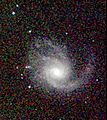Messier 99
| Messier 99 | |
|---|---|
 Spiral Galaxy M99 taken at the Mount Lemmon SkyCenter using the 0.8m Schulman Telescope | |
| Observation data (J2000 epoch) | |
| Constellation | Coma Berenices[1] |
| Right ascension | 12h 18m 49.625s[2] |
| Declination | +14° 24′ 59.36″[2] |
| Redshift | 0.008029[3] |
| Heliocentric radial velocity | 2,404 km/s[4] |
| Distance | 45.2 Mly (13.87 Mpc)[4] |
| Group or cluster | Virgo Cluster[5] |
| Apparent magnitude (V) | 10.4[3] |
| Characteristics | |
| Type | SA(s)c[6] |
| Apparent size (V) | 5.4′ × 4.7′[3] |
| Other designations | |
| Coma Pinwheel Galaxy, Virgo Cluster Pinwheel, M99, NGC 4254, PGC 39578, UGC 7345[7] | |
Messier 99 or M99, also known as NGC 4254, is a grand design spiral galaxy in the northern constellation Coma Berenices approximately 15,000,000 parsecs (49,000,000 light-years) from the Milky Way.[4] It was discovered by Pierre Méchain on 17 March 1781. The discovery was then reported to Charles Messier, who included the object in the Messier Catalogue of comet-like objects. It was one of the first galaxies in which a spiral pattern was seen. This pattern was first identified by Lord Rosse in the spring of 1846.[8]
This galaxy has a morphological classification of SA(s)c,[6] indicating a pure spiral shape with loosely wound arms. It has a peculiar shape with one normal looking arm and an extended arm that is less tightly wound. The galaxy is inclined by 42° to the line-of-sight with a major axis position angle of 68°.[5] Four supernovae have been observed in this galaxy: SN 1967H (type II),[9] 1972Q, 1986I (type II),[10] and 2014L (type Ic).[11]
A bridge of neutral hydrogen gas links NGC 4254 with VIRGOHI21, an HI region and a possible dark galaxy. The gravity from the latter may have distorted M99 and drawn out the gas bridge, as the two galaxy-sized objects may have had a close encounter before parting greatly. However, VIRGOHI21 may instead be tidal debris from an interaction with the lenticular galaxy NGC 4262 some 280 million years ago.[5] It is expected that the drawn out arm will relax to match the normal arm once the encounter is over.
While not classified as a starburst galaxy, M99 has a star formation activity three times larger than other galaxies of similar Hubble type that may have been triggered by the encounter.[12] M99 is likely entering the Virgo Cluster for the first time bound to the periphery of the cluster at a projected separation of 3.7°, or around one megaparsec, from the cluster center at Messier 87. The galaxy is undergoing ram-pressure stripping of much of its interstellar medium as it moves through the intracluster medium.[5]
Gallery
-
Image of Messier 99 taken by the NASA/ESA Hubble Space Telescope[13]
-
The NASA/ESA Hubble Space Telescope image of spiral galaxy Messier 99.
See also
- Messier 83 - a similar face-on spiral galaxy
- Pinwheel Galaxy - a similar face-on spiral galaxy
References
- ^ Dreyer, J. L. E. (1988). Sinnott, R. W. (ed.). The Complete New General Catalogue and Index Catalogue of Nebulae and Star Clusters. Sky Publishing Corporation/Cambridge University Press. ISBN 978-0-933346-51-2.
- ^ a b Skrutskie, M. F.; et al. (February 2006), "The Two Micron All Sky Survey (2MASS)", The Astronomical Journal, 131 (2): 1163–1183, Bibcode:2006AJ....131.1163S, doi:10.1086/498708.
- ^ a b c "NASA/IPAC Extragalactic Database". Results for NGC 4254. Retrieved 2006-11-25.
- ^ a b c Tully, R. Brent; et al. (August 2016), "Cosmicflows-3", The Astronomical Journal, 152 (2): 21, arXiv:1605.01765, Bibcode:2016AJ....152...50T, doi:10.3847/0004-6256/152/2/50, 50.
{{citation}}: CS1 maint: unflagged free DOI (link) - ^ a b c d Vollmer, B.; Huchtmeier, W.; van Driel, W. (September 2005). "NGC 4254: a spiral galaxy entering the Virgo cluster". Astronomy and Astrophysics. 439 (3): 921–933. arXiv:astro-ph/0505021. Bibcode:2005A&A...439..921V. doi:10.1051/0004-6361:20041350. S2CID 17414818.
- ^ a b de Vaucouleurs, G.; et al. (1991), Third reference catalogue of bright galaxies, 9, New York: Springer-Verlag.
{{citation}}: CS1 maint: multiple names: authors list (link) - ^ "M 99". SIMBAD. Centre de données astronomiques de Strasbourg. Retrieved 2009-12-18.
- ^ Jones, K. G. (1991). Messier's Nebulae and Star Clusters (2nd ed.). Cambridge University Press. ISBN 978-0-521-37079-0.
- ^ Fairall, A. P. (August 1975), "The spectrum of the type II supernova 1967h in NGC 4254", Monthly Notes of the Astronomical Society of South Africa, 34 (7–8): 94–98, Bibcode:1975MNSSA..34...94F
- ^ Penhallow, W. S.; et al. (June 1986), Marsden, B. G. (ed.), "Supernova 1986I in NGC 4254", IAU Circular, 4225 (2): 2, Bibcode:1986IAUC.4225....2P
- ^ "List of Supernovae", Central Bureau for Astronomical Telegrams, IAU, retrieved 2018-12-19
- ^ Chyży, K. T.; Ehle, M.; Beck, R. (September 2007). "Magnetic fields and gas in the cluster-influenced spiral galaxy NGC 4254. I. Radio and X-rays observations". Astronomy and Astrophysics. 474 (2): 415–429. arXiv:0708.1533. Bibcode:2007A&A...474..415C. doi:10.1051/0004-6361:20077497. S2CID 16273521.
- ^ "A Bright Spark in a Nearby Spiral Galaxy". ESA/Hubble Picture of the Week. Retrieved 4 June 2012.
External links
- SEDS: Spiral Galaxy M99
- UniverseToday: Dark Matter Galaxy?
- PPARC: New evidence for a Dark Matter Galaxy
- PTF10fqs: A Luminous Red Nova in the Spiral Galaxy Messier 99
- Messier 99 on WikiSky: DSS2, SDSS, GALEX, IRAS, Hydrogen α, X-Ray, Astrophoto, Sky Map, Articles and images

![Image of Messier 99 taken by the NASA/ESA Hubble Space Telescope[13]](http://upload.wikimedia.org/wikipedia/commons/thumb/3/32/A_Bright_Spark_in_a_Nearby_Spiral_Galaxy.jpg/120px-A_Bright_Spark_in_a_Nearby_Spiral_Galaxy.jpg)


